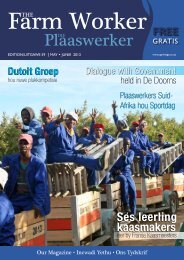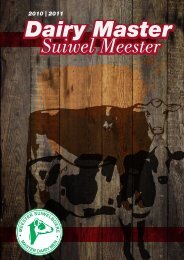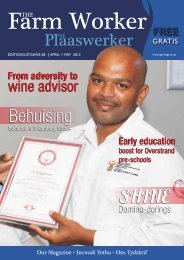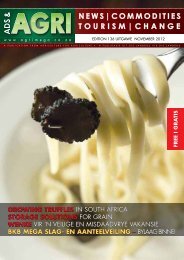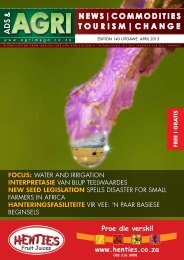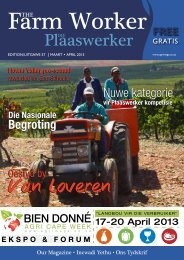Bien Donné Farm - Agri Promo
Bien Donné Farm - Agri Promo
Bien Donné Farm - Agri Promo
Create successful ePaper yourself
Turn your PDF publications into a flip-book with our unique Google optimized e-Paper software.
Mechanisation and Water:<br />
An Odd Couple<br />
Compiled by<br />
Doug Momberg<br />
AMG Media &<br />
Promiotions<br />
T<br />
he connection between water and mechanisation<br />
is not one that first meets the eye. However,<br />
deeper inspection into the relationship<br />
between the two highlights some interesting insights.<br />
It is important to realise that agriculture is the largest<br />
extractor of water resources, accounting for an estimated<br />
70% of all water consumption worldwide.<br />
A striking fact regarding water availability in the SADC<br />
countries is that the per capita water availability, which<br />
is already low, is expected to reduce by half by the<br />
year 2025. This is further compounded by the realisation<br />
that the water basins that make agriculture possible<br />
in South Africa are all shared with our regional<br />
neighbours. <strong>Agri</strong>culture, as by far the largest water<br />
extractor, is therefore poised to lead the way in addressing<br />
and determining the management and governance<br />
of these resources, before it is done on their<br />
behalf. <strong>Agri</strong>culture in this sense stands to gain, and<br />
potentially loose the most, if this is not addressed.<br />
For this to take place, a keen understanding is required<br />
about aspects and effects of water usage<br />
practices and the various ways that consumption<br />
can be limited. The international trade in agricultural<br />
commodities at the same time constitutes a trade with<br />
water in virtual form. Below is a table that displays the<br />
waterfootprint of a number of products, which demonstrates<br />
the dire need to conserve water where possible,<br />
in order to maintain the capacity to produce the<br />
food products that society relies on.<br />
Invasive alien vegetation that is, in other words, not<br />
indigenous to the region, are highly detrimental to<br />
agricultural water usage. Black Wattle, for instance,<br />
uses 6000m3/ha/annum, while Vines, on the other<br />
hand, utilise 4500m3/ha/annum. Furthermore, 55%<br />
stream-flow reductions in fynbos catchments have<br />
been reported, 23 years after planting pines. The replacement<br />
of grasslands with pines and eucalyptus<br />
in Mpumalanga, KwaZulu-Natal, and Northern Province,<br />
has resulted in streams completely drying up<br />
6-12 years after planting. Combatting this scourge<br />
highlights the first of the relationship between wa-<br />
BIEN DONNÉ AGRI CAPE WEEK 2012<br />
ter and mechanisation. Eradication of invasive alien<br />
vegetation can be approached through a number of<br />
techniques. The most effective means is the cutting<br />
down of the offending vegetation; a number of products<br />
and services are available ranging from handheld<br />
and chain saws to private contractors. Recycling<br />
of the wood can take the form of either chipping for<br />
mulch or firewood.<br />
Earth moving and tillage also have implications for the<br />
water on farms. The laws of displacement come into<br />
effect through the moving of soil. When soil is moved<br />
from one place to another, the water table adjusts accordingly.<br />
This can be either to one’s detriment or manipulated<br />
to your advantage. An understanding of the<br />
water resources in the production area can therefore<br />
be a major benefit.<br />
Irrigation is probably the most obvious connection<br />
between mechanisation and water usage. Efficient irrigation<br />
regiments are imperative for the sustainable<br />
preservation of water resources. Considering the agricultural<br />
irrigation practices in regions where water is<br />
particularly scarce, can provide insights into the possible<br />
alternatives and improvements that can systematically<br />
be brought about. Drip irrigation, for instance,<br />
has proven to be highly effective in the water scarce<br />
Middle East, with significant increases in production<br />
yields.<br />
The particular methods that are employed to best utilise<br />
and preserve the water resources available are,<br />
of course, dependent on the particular production<br />
requirements. The need, however to consider adjustments<br />
and adaptations to the manner in which water<br />
is exploited is already imperative, and will only become<br />
more necessary as time goes by.<br />
The aforementioned is also supported with the realisation<br />
that food and human security are both inextricably<br />
dependent on water security.<br />
Food Item Unit Water Footprint (l)<br />
Apple/Pear 1kg 700<br />
Beef 1kg 15 500<br />
Cabbage 1kg 200<br />
Cucumber/Pumpkin 1kg 240<br />
Lettuce 1kg 130<br />
Maize 1kg 900<br />
Olive 1kg 4 400<br />
Orange 1kg 460<br />
Peach/Nectarine 1kg 1 200<br />
Potato 1kg 250<br />
Sugar 1kg 1 500<br />
Tomato 1kg 180<br />
Wine 125ml 120<br />
Source: The water footprint of food, Professor<br />
Arjen Y. Hoekstra, University of Twente Water Centre,<br />
Netherlands.<br />
30 www.agrimega.co.za



